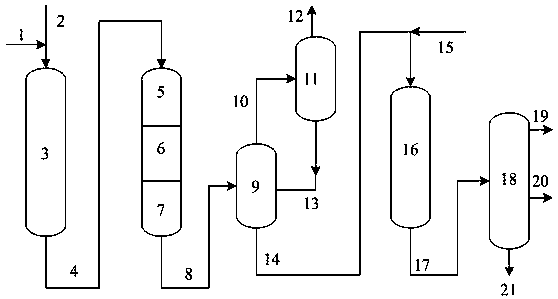A method for producing gasoline and oil with a low condensation point by a catalyst grading technology
A catalyst and gasoline technology, applied in the direction of molecular sieve catalysts, chemical instruments and methods, physical/chemical process catalysts, etc., can solve the problems of good quality hydrocracking products, catalyst process improvement, single raw material selection range, etc., to increase content, The effect of improving quality
- Summary
- Abstract
- Description
- Claims
- Application Information
AI Technical Summary
Problems solved by technology
Method used
Image
Examples
Embodiment 1
[0042] use figure 1 In the combined process flow shown, straight-run wax oil is selected as the conversion / cracking / isomerization raw material for hydrogenation to produce gasoline, and certain refining (nitrogen content 100ppm) and conversion depth (gasoline yield 30%) are controlled. The catalysts used in the examples are the commercial catalyst FF-36 hydrotreating catalyst, the special hydroconversion catalysts A, B and C single-ring aromatics retained hydroconversion catalysts, and the commercial catalyst FC-14 hydrocracking catalyst.
[0043] The properties of catalysts A, B and C are shown in Table 1, the properties of feed oil are shown in Table 2, and the operating conditions are shown in Table 3.
Embodiment 2
[0045] use figure 1 In the combined process flow shown, straight-run wax oil is selected as the conversion / cracking / isomerization raw material for hydrogenation to produce gasoline, and certain refining (nitrogen content 200ppm) and conversion depth (gasoline yield 30%) are controlled. The catalysts used in the examples are the commercial catalyst FF-36 hydrotreating catalyst, the special hydroconversion catalysts A, B and C single-ring aromatics retained hydroconversion catalysts, and the commercial catalyst FC-14 hydrocracking catalyst.
[0046] The properties of catalysts A, B and C are shown in Table 1, the properties of feed oil are shown in Table 2, and the operating conditions are shown in Table 3.
Embodiment 3
[0048] use figure 1 In the combined process shown, straight-run wax oil is selected as the conversion / cracking / isomerization raw material for hydrogenation to produce gasoline, and certain refining (nitrogen content 200ppm) and conversion depth (gasoline yield 20%) are controlled. The catalysts used in the examples are the commercial catalyst FF-36 hydrotreating catalyst, the special hydroconversion catalysts A, B and C single-ring aromatics retained hydroconversion catalysts, and the commercial catalyst FC-14 hydrocracking catalyst.
[0049] The properties of catalysts A, B and C are shown in Table 1, the properties of feed oil are shown in Table 2, and the operating conditions are shown in Table 3.
PUM
 Login to View More
Login to View More Abstract
Description
Claims
Application Information
 Login to View More
Login to View More - R&D
- Intellectual Property
- Life Sciences
- Materials
- Tech Scout
- Unparalleled Data Quality
- Higher Quality Content
- 60% Fewer Hallucinations
Browse by: Latest US Patents, China's latest patents, Technical Efficacy Thesaurus, Application Domain, Technology Topic, Popular Technical Reports.
© 2025 PatSnap. All rights reserved.Legal|Privacy policy|Modern Slavery Act Transparency Statement|Sitemap|About US| Contact US: help@patsnap.com



